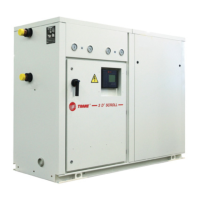Page 4
2.2
ACCESS TO DANGEROUS AREA
The access to the unit dangerous areas is usually obstructed through protection panels, which are removable,
by using a tool.
For all the units which allow access to the cooling piping without security gratings (optional) or closing panelling,
the following precautions must be taken:
-mark the areas with contact risks.
-apply warning signs.
The danger zone must be of a suitable size to avoid any contact, even accidental contact.
Trane declines any responsibility for damage to things and unauthorized personnel in case of absence of clear
and static limiting systems of the risk areas and of the relevant warning and danger signs.
2.3
GENERAL PRECAUTIONS
The operator must only intervene on the unit commands; he or she must not open any panels except for the one
which gives access to the command module.
The installer must only intervene on the connections between the plant and the machine; he or she must not
open any machine panels nor carry out any commands.
The following precautions should be made when approaching or working on the unit:
• Do not wear jewelry, baggy clothes or any other accessory which can get caught up.
• Use appropriate protection (gloves, glasses etc.) when using an open flame (welding) or compressed air.
• If the unit is located in a closed environment, wear hearing protection.
• Before disconnecting, removing tubes, filters, joints or other line parts intercept the connection tubes, empty
them until the pressure reaches that of the atmosphere.
• Do not use your hands to check for possible pressure losses.
• Always use tools which are in good condition; make sure the instructions are fully understood before using them.
• Make sure that any tools, electrical cables or other loose objects are removed before closing the unit and
starting it up again.
2.4
PRECAUTIONS AGAINST RISKS DUE TO THE REFRIGERANT
Splashes or sprinkles can cause chill burns. The risk of absorptions through the skin is not relevant.
R410a refrigerant could take some lightly irritating effects and in liquid stage it has a strong skinning effect. In
this case it is necessary to rinse with fresh water the contaminated parts of the skin
The refrigerant in liquid stage in contact with wet fabrics cause freezing and adherence to the skin. In this case it is
necessary to put off the contaminated clothes to avoid freezing. Please contact a doctor in case of irritation of the
contaminated parts.
Risks for contact with the
eyes
ors don’t take any effect. Splashes or sprinklers can cause chill burns. In those cases it is necessary to
the eyes with water or with solution for ocular washings for 10 minutes. The intervention of a doctor is needed.
Should it happen, it causes chill burns. It does not cause vomiting. The person must be kept awake. It is needed to
rinse the mouth with fr
esh water and to drink almost 0.25 liters. The intervention of a doctor is needed.
concentration of vapors in air can lead to anesthetic effects up to a loss of conscience. Long
exposures could give rise to cardiac arrhythmia and sometimes even to death.
High concentrations can create a reduction of oxygen in air, with consequent possibility of suffocation. Should it
happen the person must be taken to the open air and let him take a rest.
Administer oxygen if needed. In case the breathing has
interrupted or become irregular, it is necessary to
apply the artificial breathing. In case of cardiac arrest a heart massage must be applied. Contact a doctor
immediately.
Conditions to avoid
exposed flames, and of high levels of humidity.
Dangerous reactions
Possibility of violent reactions with the sodium, the potassium, the barium and with other alkaline
substances, incompatible materials and all the alloys containing more than 2% of
magnesium.
-
Behavior in case of losses
or escapes
Wear protection apparel and self
-rescuer respirators. Insulate the source of the loss, if this operation can be done in
safety conditions. Small quantitative of refrigerant escaped at liquid state can be allowed to evaporate only if the room is
well ventilated. In case of great losses ventilate the room immediately. Plug the loss with sand, so
il or other absorbent
material; avoid that the liquid refrigerant can enter in water
-drainages or losing pools.

